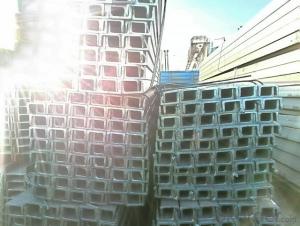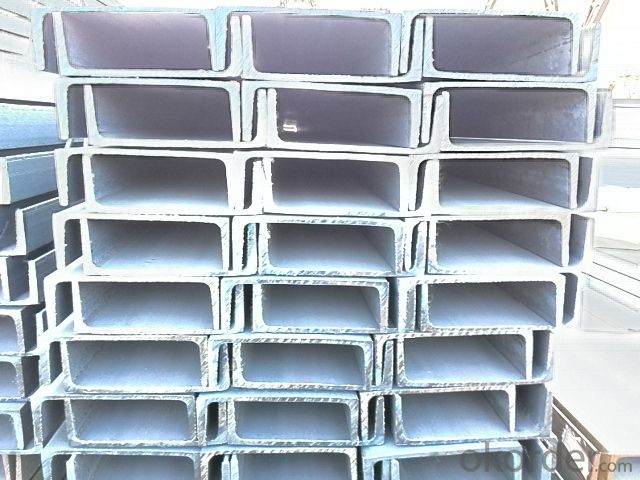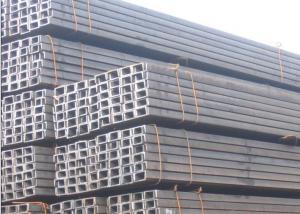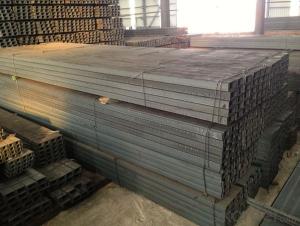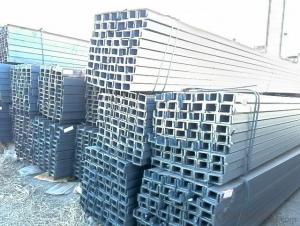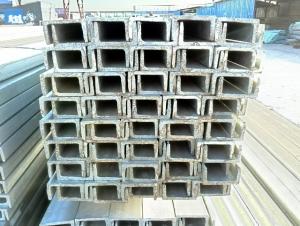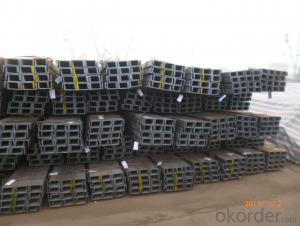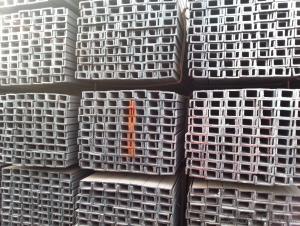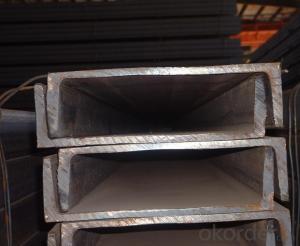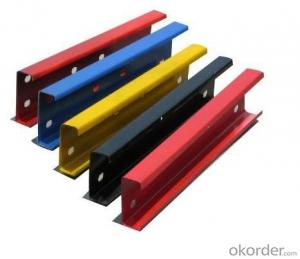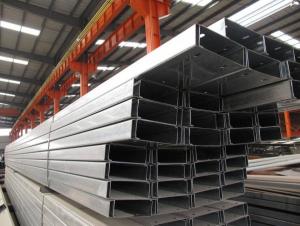JIS Standard U-Channel Beams with Competitive Price
- Loading Port:
- Tianjin
- Payment Terms:
- TT OR LC
- Min Order Qty:
- 25 m.t.
- Supply Capability:
- 10000 m.t./month
OKorder Service Pledge
OKorder Financial Service
You Might Also Like
Product Description:
| Minimum Order Quantity: | 25MT | Unit: | m.t. | Loading Port: | Xingang Port |
| Supply Ability: | 120000TON/Year | Payment Terms: | TT or LC |
Product Applications:
Japanese Standard U-channels are ideal for structural applications and are widely used in the construction of buildings and bridges, and the manufacturing, petrochemical, and transportation industries.
Product Advantages:
OKorder's Japanese Standard U-channels are durable, strong, and resist corrosion.
Main Product Features:
· Premium quality
· Prompt delivery & seaworthy packing (30 days after receiving deposit)
· Corrosion resistance
· Can be recycled and reused
· Mill test certification
· Professional Service
· Competitive pricing
Product Specifications:
Manufacture: Hot rolled
Grade: Q195 – 235
Certificates: ISO, SGS, BV, CIQ
Length: 6m – 12m, as per customer request
Packaging: Export packing, nude packing, bundled
1. We are definitely speciallizing in manufacturing and supplying channel steel as per japanese standard, which is characterised with high mechanical strength and competitive prices.
Original Place | Tangshan, China | Brand Name | UINDA |
Standard | JIS G3192 : 1990 | ||
Material Grade | SS490 | ||
Sizes | 50mm to 200mm | ||
Sales Volume/Year | 3000MT | ||
Destination Area | Middle East, Africa, Southeast Asia | ||
2. The sections in details are as followings in the table-1
JIS U CHANNEL | Standard | Sectional | Dimension |
| Mass: |
| (mm) | (mm) | (mm) | (mm) |
|
50x25 | 50 | 25 | 3.0 | 6.00 | 2.37 |
75X40 | 75 | 40 | 3.8 | 7.00 | 5.30 |
75X40 | 75 | 40 | 4.0 | 7.00 | 5.60 |
75X40 | 75 | 40 | 4.5 | 7.00 | 5.85 |
75X40 | 75 | 40 | 5.0 | 7.00 | 6.92 |
|
|
|
|
|
|
100X50 | 100 | 50 | 3.8 | 6.00 | 7.30 |
100X50 | 100 | 50 | 4.2 | 6.00 | 8.03 |
100X50 | 100 | 50 | 4.5 | 7.50 | 8.97 |
100X50 | 100 | 50 | 5.0 | 7.50 | 9.36 |
|
|
|
|
|
|
125X65 | 125 | 65 | 5.2 | 6.80 | 11.66 |
125X65 | 125 | 65 | 5.3 | 6.80 | 12.17 |
125X65 | 125 | 65 | 5.5 | 8.00 | 12.91 |
125X65 | 125 | 65 | 6.0 | 8.00 | 13.40 |
|
|
|
|
|
|
150x75 | 150 | 75 | 5.5 | 7.30 | 14.66 |
150x75 | 150 | 75 | 5.7 | 10.00 | 16.71 |
150x75 | 150 | 75 | 6.0 | 10.00 | 17.90 |
150x75 | 150 | 75 | 6.5 | 10.00 | 18.60 |
150x75 | 150 | 75 | 6.5 | 10.00 | 24.00 |
|
|
|
|
|
|
200X80 | 200 | 80 | 7.5 | 11.00 | 24.60 |
Table-1
3. The mechanical property of JIS U Channel Steel in the table-2:
Grade | Yield Strength,N/mm² | Extension Strength N/mm² | |||
Thickness of Steel,mm | |||||
≦16 | >16-≦40 | >40-≦100 | >100 | ||
SS490 | ≧285 | ≧275 | ≧255 | ≧245 | 490-610 |
Table-2
4. The chemical composition of JIS U Channel Steel as per SS490 in the table-3
Grade | Element(%) | |||
C | Mn | P | S | |
SS490 | - | - | ≦0.050 | ≦0.050 |
Table-3
FAQ:
Q1: Why buy Materials & Equipment from OKorder.com?
A1: All products offered byOKorder.com are carefully selected from China's most reliable manufacturing enterprises. Through its ISO certifications, OKorder.com adheres to the highest standards and a commitment to supply chain safety and customer satisfaction.
Q2: How do we guarantee the quality of our products?
A2: We have established an advanced quality management system which conducts strict quality tests at every step, from raw materials to the final product. At the same time, we provide extensive follow-up service assurances as required.
Q3: The products are invoicing on theoritical weight or on actual weight?
A3: We can do it in both manners, according to the customers' request.
Images:
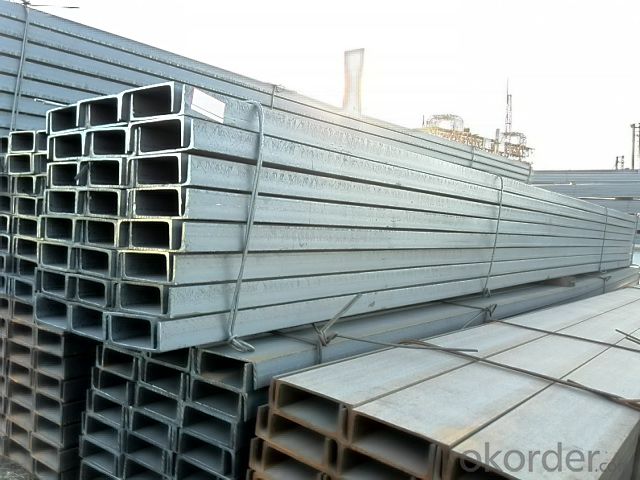
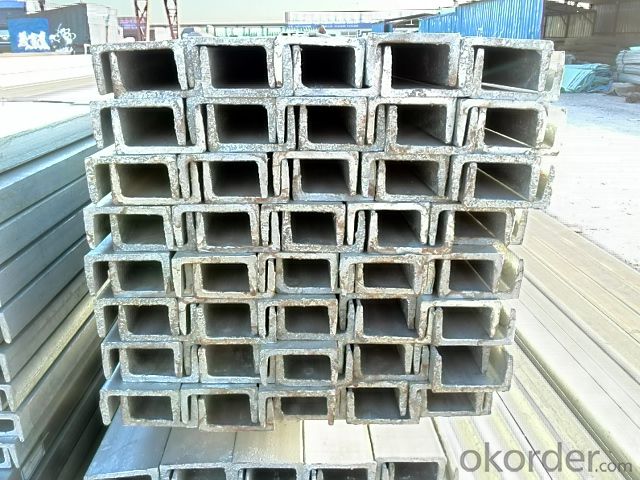
- Q: What are the factors to consider when determining the spacing of steel channels in a structure?
- There are several factors to consider when determining the spacing of steel channels in a structure. These factors include the load-bearing capacity of the channels, the desired level of structural integrity, the type and magnitude of the loads that will be applied to the structure, and the design requirements and building codes that need to be followed. Firstly, the load-bearing capacity of the steel channels is a crucial factor in determining their spacing. The channels must be able to support the expected loads without experiencing excessive deflection or failure. This requires considering the material properties of the channels, such as their yield strength and modulus of elasticity, as well as the specific dimensions and geometry of the channels. Secondly, the desired level of structural integrity is an important consideration. The spacing of the steel channels should be determined in a way that ensures the overall stability and strength of the structure. This involves analyzing the potential modes of failure, such as buckling or bending, and designing the spacing to prevent these failures from occurring under the expected loads. Thirdly, the type and magnitude of the loads that will be applied to the structure must be taken into account. Different types of loads, such as dead loads (permanent loads like the weight of the structure itself) and live loads (temporary loads like the weight of people or equipment), can have varying effects on the steel channels. The spacing should be chosen to distribute the loads evenly and prevent localized stress concentrations. Furthermore, it is essential to consider the design requirements and building codes that govern the construction of the structure. These regulations often provide specific guidelines for the spacing of steel channels based on factors such as the span of the structure, the type of building, and the intended use of the structure. Adhering to these standards ensures that the structure meets safety and performance criteria. In conclusion, determining the spacing of steel channels in a structure requires careful consideration of factors such as load-bearing capacity, structural integrity, applied loads, and design requirements. By evaluating these factors, engineers can make informed decisions to ensure the stability, strength, and compliance of the structure.
- Q: Can steel channels be used in industrial buildings?
- Yes, steel channels can be used in industrial buildings. Steel channels, also known as C-channels or U-channels, are structural members made of steel that have a C or U shape. They are commonly used in construction and industrial applications due to their strength and versatility. Steel channels can be used in industrial buildings for various purposes. They are often used as support beams or columns to provide structural stability and load-bearing capacity. Steel channels can effectively distribute the weight of heavy machinery, equipment, and materials, making them suitable for industrial applications where there is a need for strong and durable structural components. Additionally, steel channels can be used for framing walls, roofs, and floors in industrial buildings. They can be easily connected and welded together to create rigid and stable frames. Steel channels also offer flexibility in design, as they can be cut and shaped to fit specific requirements and specifications. Furthermore, steel channels have excellent resistance to corrosion, making them suitable for industrial environments that may expose the building to moisture, chemicals, or other harsh conditions. They have a long lifespan and require minimal maintenance, which is advantageous for industrial buildings that need to withstand heavy usage and demanding operations. Overall, steel channels are a popular choice in industrial buildings due to their strength, versatility, and resistance to corrosion. They provide structural stability, support heavy loads, and offer design flexibility. Whether it is for support beams, framing, or other applications, steel channels can effectively meet the requirements of industrial buildings.
- Q: Are steel channels suitable for data center construction?
- Yes, steel channels are suitable for data center construction. They provide strength and durability required for supporting heavy equipment and infrastructure in data centers. Steel channels also offer flexibility for customization and ease of installation, making them a commonly used material in data center construction.
- Q: Can steel channels be used for scaffoldings?
- Scaffoldings can indeed utilize steel channels. In the construction industry, steel channels find widespread use for a multitude of purposes, one of which includes scaffolding systems. They possess exceptional strength, durability, and load-bearing capabilities, making them a fitting option for supporting both workers and materials at elevated heights. The assembly and disassembly of steel channels are effortless, allowing for a scaffold design that is flexible and adaptable. Moreover, their resistance to corrosion renders them perfect for outdoor applications, where exposure to weather elements is a concern. All in all, steel channels provide a dependable and robust solution for scaffoldings, guaranteeing the safety and stability of both workers and the construction project.
- Q: Are steel channels suitable for earthquake-prone regions?
- Steel channels are indeed suitable for earthquake-prone regions. Steel is known for its high strength and ductility, making it a popular choice for earthquake-resistant construction. Steel channels, in particular, offer several advantages in seismic regions. Firstly, steel channels possess excellent load-bearing capabilities, allowing them to withstand the forces generated during an earthquake. Their shape provides structural rigidity and stability, minimizing the risk of collapse or damage. Steel's inherent flexibility also enables it to absorb and dissipate seismic energy, reducing the impact on the overall structure. Additionally, steel channels can be easily customized and fabricated to meet specific building requirements. This adaptability allows engineers to design structures with appropriate seismic resistance, ensuring that they can withstand the expected ground motion. Steel channels' dimensional accuracy and uniformity also contribute to better construction quality and performance during earthquakes. Another advantage of steel channels is their fire resistance. Unlike other building materials, such as wood or concrete, steel does not burn or contribute to the spread of fire. This characteristic makes steel channels a safer choice for earthquake-prone regions, where fires can often occur due to ruptured gas lines or electrical failures during seismic events. Moreover, steel's durability and resistance to corrosion make it ideal for long-term use in earthquake-prone areas. Steel channels require minimal maintenance and have a longer lifespan compared to other materials, ensuring the continued safety and stability of structures over time. In conclusion, steel channels are highly suitable for earthquake-prone regions due to their strength, ductility, load-bearing capabilities, adaptability, fire resistance, and durability. These qualities make steel channels a reliable choice for constructing earthquake-resistant buildings that can withstand the forces generated by seismic events.
- Q: What are the factors to consider when determining the appropriate length of a steel channel?
- When determining the appropriate length of a steel channel, several factors need to be considered. These factors include the intended use and load-bearing capacity of the channel, the dimensions and specifications of the structure it will be incorporated into, as well as any potential environmental factors such as temperature fluctuations or exposure to corrosive substances. Additionally, considering the availability and cost of different lengths of steel channels can also be important in making a practical and cost-effective decision.
- Q: Are steel channels suitable for temporary structures?
- Indeed, steel channels prove to be a fitting choice for temporary structures. Given their robustness and endurance, steel channels find frequent application in construction. Their adaptability enables easy fabrication and assembly, permitting the creation of temporary structures like scaffolding, shoring, and temporary supports. By offering stability and the capability to bear substantial loads, steel channels prove ideal for bolstering temporary structures during construction or event arrangements. Furthermore, steel channels exhibit weathering resistance and the capacity to withstand hefty burdens, thereby ensuring the safety and stability of these transient structures.
- Q: Are steel channels suitable for marine applications?
- Steel channels are highly suitable for marine applications due to their strength and durability. They are crafted from a resilient material that is resistant to corrosion, making them an ideal choice for marine settings where saltwater exposure is constant. These channels are capable of enduring the harsh conditions of the ocean, including high levels of moisture, waves, and wind. Furthermore, they possess exceptional structural integrity and can provide support and stability for various marine structures like piers, docks, and offshore platforms. In addition to this, they are commonly employed in shipbuilding and the construction of marine vessels. All in all, steel channels offer a reliable and practical solution for marine applications as they possess the necessary strength, corrosion resistance, and ability to withstand the demanding conditions of the marine environment.
- Q: Can steel channels be used in the construction of railings or handrails?
- Yes, steel channels can be used in the construction of railings or handrails. Steel channels are often chosen for their strength and durability, making them a suitable material for supporting and securing railings or handrails. They can be easily fabricated and installed, providing a sturdy structure that can withstand heavy loads and ensure the safety of individuals using the railing or handrail. Additionally, steel channels can be designed in various shapes and sizes, allowing for flexibility in creating different railing or handrail designs to suit specific architectural requirements.
- Q: Are steel channels available in pre-fabricated lengths?
- Yes, steel channels are available in pre-fabricated lengths. Steel channels are commonly used in construction and engineering projects, and they can be manufactured in various lengths to suit different applications. These pre-fabricated lengths make it easier for builders and contractors to work with the steel channels, as they can be easily transported and installed on-site. Additionally, pre-fabricated lengths help to ensure consistency in dimensions and quality, as they are produced in controlled environments using specialized equipment.
Send your message to us
JIS Standard U-Channel Beams with Competitive Price
- Loading Port:
- Tianjin
- Payment Terms:
- TT OR LC
- Min Order Qty:
- 25 m.t.
- Supply Capability:
- 10000 m.t./month
OKorder Service Pledge
OKorder Financial Service
Similar products
Hot products
Hot Searches
Related keywords
